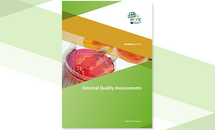Tenth external quality assessment scheme for Salmonella typing
ECDC is supporting a large number of targeted External Quality Assessment (EQA) schemes with voluntary participation by reference or primary laboratories, which are active members of EU surveillance networks. The rationale for these EQAs is to underpin the capability and reliability of infectious disease case detection and confirmation or agent characterisation as used for data reporting to EU surveillance and alert systems.
Executive summary
This report presents the results of the 10th round of the external quality assessment (EQA-10) scheme for typing of Salmonella enterica subsp. enterica organised for the national public health reference laboratories (NPHRLs) in ECDC’s Food- and Waterborne Diseases and Zoonoses network (FWD-Net), managed by the European Centre for Disease Prevention and Control (ECDC). The EQA-10 scheme was arranged by the Section for Foodborne Infections at the Statens Serum Institut (SSI) in Denmark.
Salmonellosis was the second most commonly reported zoonotic disease in the European Union (EU) in 2018, with a notification rate of 20.1 cases per 100 000 population. The most commonly reported Salmonella serovars in 2018 were S. Enteritidis, S. Typhimurium, monophasic S. Typhimurium, and S. Infantis. The total number of reported cases was 91 857 [3]. Since 2007, ECDC has been responsible for the EU-wide surveillance of salmonellosis, including facilitating the detection and investigation of food-borne outbreaks. Surveillance data, including certain basic typing parameters, are reported by Member States to The European Surveillance System (TESSy). Since 2012, the EQA scheme has covered molecular typing methods used for EU-wide surveillance.
The effective molecular typing-enhanced surveillance relies on the capacity of NPHRLs in the FWD-Net to produce comparable typing results. ECDC has opened the possibility to Member States to submit WGS data for Salmonella and Listeria monocytogenes to TESSy to be used for EU-wide surveillance and cross-sector comparison. The previous EQA schemes from EQA-4 to EQA-8 included assessment of the PFGE typing methods for all Salmonella serovars and multiple locus variable number of tandem repeats analysis (MLVA) for Salmonella Typhimurium (STm). Since EQA-9, the PFGE part was modified into a part where the ability of identifying a cluster based on molecular typing by either PFGE, MLVA, and/or whole genome sequencing (WGS) derived data was assessed. Since EQA-9, participants have also been able to participate in MLVA for S. Enteritidis (SE).
The objectives of the EQA-10 scheme were to assess the quality of data and comparability of molecular typing analysis results produced by NPHRLsin FWD-Net. Test isolates for the EQA were selected to cover isolates currently relevant for public health in Europe. Three sets of 10 isolates were selected, including S. Typhimurium and S. Enteritidis isolates for the two MLVA methods and a mixture of different sequence types (ST) in the cluster analysis.
Twenty-two laboratories signed up, and 19 completed the exercise. This is a decrease from EQA-9 (N=23) with 17%. It is unknown if the removal of the PFGE part (gel quality and analysis) was the cause of this. All 19 laboratories participated in the molecular typing-based cluster analysis. Out of the 19 laboratories participating in EQA-10, 15 (79%) performed molecular typing-based cluster analysis, which was 25% (12 laboratories participated) increase compared to EQA-9.
In total, eight laboratories participated in the S. Typhimurium MLVA and nine participated in the S. Enteritidis MLVA. For the S. Typhimurium and S. Enteritidis MLVA schemes, a lower number of participants was observed compared with previous EQA-9, when 10 laboratories participated. The performance level was high for both analyses (93%) and within the range of the previous years. One laboratory was responsible for 50% of the errors in S. Typhimurium and 66% in the S. Enteritidis.
The aim of the cluster analysis part of the EQA was to assess the NPHRL’s ability to identify a cluster of genetically closely related isolates i.e. correctly categorise cluster test isolates regardless of the method used, instead of the ability to follow a specific procedure.
The cluster of closely related monophasic S. Typhimurium ST34 isolates could be identified by PFGE, MLVA, and WGS-derived data. The expected cluster was based on a predefined categorisation by the organiser and contained four isolates based on WGS-derived data.
Seven laboratories used PFGE for cluster analysis, and for two participants PFGE was the only cluster identification method. Six laboratories were able to identify the correct cluster using PFGE. Five laboratories used MLVA for cluster analysis in combination with either PFGE or WGS and all identified the correct cluster. One laboratory performed cluster analysis using all three methods.
The performance among the 15 participants using WGS derived data was very high, 14 (93%) correctly identified the cluster of closely related isolates. In this EQA cluster analysis, the focus has been on one test isolate (REF6), where challenges and discrepancies among the participants interpretation of whether REF6 should be included in the cluster of closely related isolates. Both inclusion and exclusion of REF6 was accepted as a correct result. Sixty percent of the participants did not include REF6 in the cluster, which is in accordance with “original” pre-defined cluster by the provider.
The results were comparable between single nucleotide polymorphism (SNP) and allele-based analysis, but the allele-based analysis gave a less clear discrimination and resulted in different interpretation by the participants (REF6).
In this EQA, the EQA provider introduced an additional part to the molecular typing-based cluster analysis: an assessment of four EQA provided genomes. In an urgent outbreak situation, the sequence data available is not always of high quality, therefore this EQA-part was designed to mimic this situation. The participants should assess additional genomes, some were modified by the EQA provider in order to give a realistic view of different quality issues. The majority of participants (87%-100%; 13-15/15) successfully identified the genomes of high quality as a cluster isolate and 14 of 15 the non-cluster isolate. The inclusion of E. coli species in one of the genomes were only described by five participants, but 13 of 15 did identify the genome as a non-cluster isolate. The genome with the poor quality in one of the genomes were observed by 13 of 15 participants.
Download





